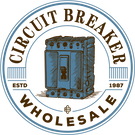What are the Common Sizes of Circuit Breakers?
There are various sizes of circuit breakers; each with its own advantages and disadvantages. You can see the different sizes of circuit papers when you look inside the main load center with the electrical circuits that power your lights. Standard-sized circuit breakers are often used to power 120-volt circuits. However, the type of circuit breaker in a circuit is determined by the location of the outlet, expected use of the outlet, and the electrical equipment they will power. Individual appliances are usually powered by a 240-volt circuit and are usually sized according to the amperage requirement of the appliance to which they are dedicated.

Minimum Size
Circuits that power living areas of residential units are often protected by 15-amp circuit breakers. Electrical appliances such as radios, televisions, computers, and lights found in such areas normally have much lower amperage demands. Even if you power on several of such electrical devices simultaneously, they are likely not to overload the 15-amp circuit breaker.
Large Size
According to the National Electric Code, kitchens, garages, laundry rooms, and other specified areas should be protected by at least 20-amp circuit breakers. It is advisable to use high-power tools and electrical appliances in areas that draw higher amperage from your home’s electrical outlet.
Mega-Size
It is unusual to use circuit breakers that are larger than 20-amp in home installations. However, you can know in advance the required amperage of your home or room when rewiring, remodeling, or building. This gives you adequate time to upgrade your circuit if necessary.220 Circuits
High-powered electrical equipment such as heaters, stoves, air conditioners, and water pumps are often individually protected by varying sizes of circuit breakers ranging from 20 to 60 amps depending on the size of the relevant appliance. In addition, unattached garages or workshops at your home that are powered by your main load center are usually protected by 60 to 100 amp circuit breakers that break the electricity into smaller units in the remote building.
Types of Faults
Electrical faults fall into two major categories: overloads and short circuits. Overloads may be caused by lightning strikes or other sources of a power surge. On the other hand, a short circuit occurs when there is a diversion of electricity from what was intended. A dangerous trait of electricity is that it follows the shortest path to the ground. Electrical currents will find the path even if it is just a tiny hole in the cord resulting in an electricity leak.
A Circuit
Once electricity enters your home or office, it is distributed to all the circuits behind your walls to power electrical appliances and devices that are plugged in. A circuit breaker is often found on a circuit breaker box hanging on the wall of your basement, garage, or closet. The circuit breaker box consists of various switches, much like the ones you use to turn on your lights. The electricity that comes into your home is divided among all the circuits in the building. The main role of circuit breakers is to stop the usual flow of electricity in case of an electrical fault to prevent damage to your electrical appliances, injuries, or fire.




